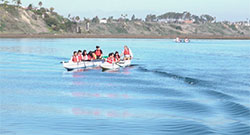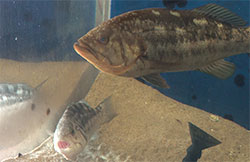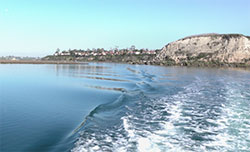Paddleboarder enjoys Upper Newport Bay

Boaters in Upper Newport Bay

Fish at Back Bay Science Center

Upper Newport Bay, looking upstream
When you learn there’s a popular piece of property on the Southern California coast taking up more than 750 acres, you wouldn’t be faulted for imagining a marina, a golf course, a resort – or all three.
But one piece of land and (mostly) water is important and popular for what hasn’t been built there. The Upper Newport Bay Ecological Reserve showcases the beautiful California coast, unspoiled and filled with wildlife, plants and fabulous scenery.
The reserve is one of 749 properties carefully managed by the California Department of Fish and Wildlife (CDFW). Located in the heart of Newport Beach, in Orange County, the reserve is completely surrounded by some of the most highly valued real estate in the country. The University of California, Irvine, isn’t far away – neither is John Wayne Airport. But that’s all forgotten when exploring the reserve on foot, by boat or paddleboard, or with binoculars.
“People don’t realize how few areas exist like this anymore in Southern California, or that we have marshes in California. It’s not what people think of about the California coast; they think of beaches,” said Reserve Manager Dr. Amanda Swanson. “People can live one city over and not know this even exists.”
The reserve was created in 1975, at a time when developers most certainly would have jumped at the chance to turn this area into a profitable commercial property of some sort. Instead, it offers peaceful and scenic experiences for people looking to hike, fish, watch birds or view tidepools. Of equal importance, the reserve plays a large role in protecting wildlife and vegetation that isn’t as plentiful today as it once was.
“The reason this is so heavily protected – and why it’s a reserve now – is because we have a lot of really sensitive wildlife and vegetation here,” Swanson said. “We’ve lost 85 to 90 percent of our coastal wetlands in Southern California, and it’s one of the few large ones we have left. For that reason, unfortunately, we have multiple endangered species.”
Specific endangered plants on the reserve include salt marsh bird’s beak, while several bird species – Ridgway’s rail, Belding’s savannah sparrow, Least bell’s vireo, coastal California gnatcatcher and cactus wren – are either endangered or threatened.
The reserve offers an outstanding educational opportunity as well, with the presence of the Back Bay Science Center. CDFW partners with the city of Newport Beach, Orange County, the Newport Bay Conservancy and UC Irvine in operating the Science Center, which serves as a teaching and research facility at the reserve. Thousands of students, middle school age through college, visit the Center each year to learn about watershed and ecological concepts, habitat restoration and marine life. There’s no shortage of available lessons for anyone who visits the science center or reserve. (Due to COVID-19, the reserve is temporarily closed. Information on at-home programs and resources at the Science Center is available at  backbaysciencecenter.org.)
backbaysciencecenter.org.)
“Coastal wetlands like Upper Newport Bay can provide several ecosystem services such as coastal protection from storms and flood protection. Then there’s filtration – we unfortunately have trash come down the watershed, so the wetlands can prevent some of that trash from making its way into the ocean, which gives us the opportunity to remove it,” Swanson said. “Wetlands also effectively cycle nutrients through processes that purify the water and store carbon in the soil.”
Changes in the carbon cycle are of particular concern as increased atmospheric CO2 is a contributor to climate change, added Swanson. The plants in coastal wetlands contribute to the carbon cycle because they consume and transform atmospheric CO2 through photosynthesis. When these plants die, they then transfer the carbon to the soil where it can be stored for long periods of time.
CDFW Senior Environmental Scientist Robin Madrid emphasized the important restoration work being done at the reserve for an aquatic plant called eelgrass. That work is being done by CDFW staff along with Orange County Coast Keeper, volunteers and California State University, Fullerton.
“Eelgrass provides a number of important ecosystem functions, including foraging areas and shelter to young fish and invertebrates, food for migratory waterfowl and sea turtles, and stabilizing sediment,” said Madrid.
Other restoration projects are also in progress to establish more suitable habitat for wildlife and to provide Upper Newport Bay with some resiliency to sea level rise. Completing the Big Canyon Restoration and Adaptation Project has been a goal of the City of Newport Beach and CDFW for several years. The second phase of the project is beginning this fall and will remove several acres of invasive Brazilian peppertrees, restore the hydrology and establish a mosaic of native wetland and transitional upland habitats. The design for the final phase of the project will also begin this fall. The project’s ongoing success can be attributed to the strong collaborative efforts between the landowners, local stakeholders and nonprofits.
With so much scientific work going on at the Upper Newport Bay Ecological Reserve, Swanson and her staff are careful not to lose track of the impacts on young visitors who might be seeing the marshes, mudflats and marine habitats for the very first time.
“It’s been surprising and impressive to me, that there’s such a great interest in bringing kids, especially those from disadvantaged communities, here to learn. Many of them aren’t often able to get out to the beach, so this is a fun and unique opportunity. They see the wildlife and their lives can be changed,” said Swanson.
Swanson recalls presenting to a group of fifth graders participating in the Newport Bay Conservancy’s Fostering Interest in Nature program. “I was so impressed with the kids I met and their enthusiasm for learning about the plants and animals on the reserve. Seeing their excitement and appreciation for nature has been one of my most rewarding experiences.”
 VIDEO: Upper Newport Bay Ecological Reserve and Back Bay
VIDEO: Upper Newport Bay Ecological Reserve and Back Bay
Media Contact:
Tim Daly, CDFW Communications (916) 201-2958
CDFW photos